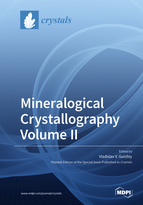Mineralogical Crystallography (2nd Edition)
A special issue of Crystals (ISSN 2073-4352). This special issue belongs to the section "Mineralogical Crystallography and Biomineralization".
Deadline for manuscript submissions: closed (31 May 2022) | Viewed by 36189
Special Issue Editor
Interests: crystallography; mineralogy; X-ray diffraction; uranium; inorganic chemistry; radiochemistry
Special Issues, Collections and Topics in MDPI journals
Special Issue Information
Dear Colleagues,
In mineralogy, crystallography remains one of the main sources of information about natural crystalline substances. A description of mineral species shapes is made according to the principles of geometric crystallography; the crystal structure of minerals is determined using X-ray crystallography techniques, and physical crystallography approaches allow one to evaluate various properties of minerals, etc. However, the reverse comparison should not be forgotten as well: crystallography science, in its current form, was born in the course of mineralogical research, long before preparative chemistry received such extensive development. It is worth saying that, even today, investigations of crystallographic characteristics of minerals regularly open up new horizons in materials science, because the possibilities of nature (fascinating chemical diversity; great variation of thermodynamic parameters; and, of course, almost endless processing time) are still not available for reproduction in any of the world's laboratories. This Special Issue is devoted to mineralogical crystallography, the oldest branch of crystallographic science, and aims to collect important surveys covering topics indicated in the keywords below.
The first volume of the “Mineralogical Crystallography” Special Issue (https://0-www-mdpi-com.brum.beds.ac.uk/journal/crystals/special_issues/mineralogical_crystallography) features eleven important surveys covering such topics as the discovery of new mineral species; crystal chemistry of minerals and their synthetic analogs; behavior of minerals at non-ambient conditions; biomineralogy; and crystal growth techniques. The first volume of the Special Issue appeared to be very fruitful, so this online issue has been also published as a printed book version (https://0-www-mdpi-com.brum.beds.ac.uk/books/pdfview/book/2952). We hope that the continuation will be just as successful, and the new set of reviews and articles will again arouse genuine interest among readers and, perhaps, push them to their own successful research. So, we are very pleased to announce that the second volume of the “Mineralogical Crystallography” Special Issue is now open to receive your manuscripts.
We invite you to participate in this issue and to contribute your research results in the fields of new mineral species discovery, structural studies of minerals and related synthetic materials, crystal chemical overviews of various mineral groups, the evolution of mineral species and their crystal structures, and descriptions of growth processes and the properties of the natural crystalline compounds.
Best regards,
Dr. Vladislav V. Gurzhiy
Guest Editor
Manuscript Submission Information
Manuscripts should be submitted online at www.mdpi.com by registering and logging in to this website. Once you are registered, click here to go to the submission form. Manuscripts can be submitted until the deadline. All submissions that pass pre-check are peer-reviewed. Accepted papers will be published continuously in the journal (as soon as accepted) and will be listed together on the special issue website. Research articles, review articles as well as short communications are invited. For planned papers, a title and short abstract (about 100 words) can be sent to the Editorial Office for announcement on this website.
Submitted manuscripts should not have been published previously, nor be under consideration for publication elsewhere (except conference proceedings papers). All manuscripts are thoroughly refereed through a single-blind peer-review process. A guide for authors and other relevant information for submission of manuscripts is available on the Instructions for Authors page. Crystals is an international peer-reviewed open access monthly journal published by MDPI.
Please visit the Instructions for Authors page before submitting a manuscript. The Article Processing Charge (APC) for publication in this open access journal is 2600 CHF (Swiss Francs). Submitted papers should be well formatted and use good English. Authors may use MDPI's English editing service prior to publication or during author revisions.
Keywords
- Minerals
- Crystallography
- Crystal chemistry
- X-ray diffraction
- Crystal structures
- Crystal growth
- Mineral evolution
Related Special Issue
- Mineralogical Crystallography in Crystals (12 articles)






